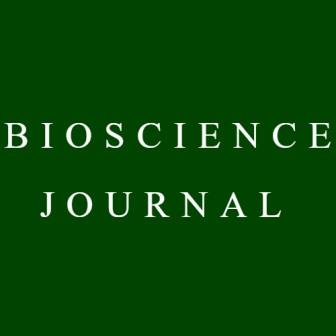EFEITOS DO BLOQUEIO DO NERVO AURICULOPALPEBRAL NOS PARÂMETROS OCULARES EM CÃES
DOI:
https://doi.org/10.14393/BJ-v37n0a2021-54175Palavras-chave:
Bupivacaine, Dog, Locorregional Anesthesia, Ropivacaine.Resumo
O objetivo desse estudo foi comparar os efeitos de dois anestésicos locais utilizados no bloqueio auriculopalpebral sobre a acinesia das pálpebras, a produção lacrimal, a pressão intraocular (PIO) e o tempo de ruptura do filme lacrimal (TRFL) em cães conscientes. Realizou-se um estudo prospectivo, randomizado e cego para determinar os efeitos do bloqueio auriculopalpebral utilizando a ropivacaína 0,75% e a bupivacaína 0,5% em 12 cães hígidos não braquiocefálicos (24 olhos). Foram realizados os testes de resposta à ameaça e de reflexo palpebral, o teste lacrimal de Schirmer (TLS), a PIO e o tempo de ruptura do filme lacrimal antes do bloqueio e aos 30, 60, 120, 240 e 360 minutos após a aplicação. Observou-se diferença entre os valores encontrados aos 30, 60, 120 e 240 minutos em relação ao momento basal para os testes de resposta à ameaça e de reflexo palpebral nos dois grupos avaliados, comprovando a acinesia palpebral após os bloqueios. Verificou-se que não houve diferença para o TLS, a PIO e o TRFL entre os valores basais e os tempos pós-anestesia ou entre os grupos. Foi possível concluir que a ropivacaína e a bupivacaína no bloqueio auriculopalpebral em cães conscientes promoveram acinesia palpebral durante pelo menos 240 minutos, sem alterar os parâmetros fisiológicos oculares da produção lacrimal, da pressão intraocular e do tempo de ruptura do filme lacrimal após o bloqueio.
Downloads
Referências
BAYLEY, K.D. and READ, R.A. Sub-Tenon's anesthesia for canine cataract surgery. Veterinary Ophthalmology. 2018, 21(6), 601-611. https://doi.org/10.1111/vop.12554
BERKUN, Y., et al. Evaluation of adverse reactions to local anesthetics: experience with 236 patients. Annals of Allergy, Asthma & Immunology. 2003, 91(4), 342-345. https://doi.org/10.1016/s1081-1206(10)61680-8
CALDERON, A.L., et al. Immediate allergic cross-reactivity to levobupivacaine and ropivacaine. Anaesthesia. 2012, 68(2), 203-205. https://doi.org/10.1111/j.1365-2044.2012.07314.x
CARARETO, R., et al. Anestesia para cirurgias oftálmicas em canídeos. Revista Portuguesa de Ciências Veterinárias. 2007, 102(561/562), 35-42.
CULLEN, C.L., LIM, C. and SYKES, J. Tear film breakup times in young healthy cats before and after anestesia. Veterinary Ophthalmology. 2005, 8(3), 159-65. https://doi.org/10.1111/j.1463-5224.2005.00347.x
DOUET, J.Y., et al. Effect of sedation with butorphanol on variables pertaining to the ophthalmic examination in dogs. Veterinary Ophthalmology. 2018, 21(5), 452-458. https://doi.org/10.1111 /vop.12530
ESTEVES, A., et al. Anatomical description of the trigeminal nerve [v] and its branching in mongrel dogs. Brazilian Journal of Morphological Sciences. 2009, 26(3-4), 187-192.
EVANGELHO, K., MASTRONARDI, C.A. and DE-LA-TORRE, A. Experimental Models of Glaucoma: A Powerful Translational Tool for the Future Development of New Therapies for Glaucoma in Humans - A Review of the Literature. Medicina. 2019, 55(6), 280. https://doi.org/10.3390/medicina55060280
FEATHERSTONE, H.J. and HEINRICH, C.L., 2013. Ophthalmic Examination and Diagnostics. In: GELATT, K.N., GILGER, B.C. and KERN, T.J. Veterinary Ophthalmology. Iowa: John Wiley & Sons, pp. 533-613.
HAMOR, R.E., et al. Evaluation of results for Schirmer tear tests conducted with and without application of a topical anesthetic in clinically normal dogs of 5 breeds. American Journal of Veterinary Research. 2000, 61(11), 1422-1425. https://doi.org/10.2460/ajvr.2000.61.1422
HARTLEY, C., WILLIAMS, D.L. and ADAMS, V.J. Effect of age, gender, weight, and time of day on tear production in normal dogs. Veterinary Ophthalmology. 2006, 9(1), 53-57. https://doi.org/10.1111/j.1463-5224.2005.00437
HONSHO, C.D.S., et al. Ocular effects of retrobulbar block with different local anesthetics in healthy dogs. Semina: Ciências Agrárias. 2014, 35(5), 2577-2589. https://doi.org/10.5433/1679-0359.2014v35n5p2577
KLAUMANN, P.R. Bloqueio peribulbar com ropivacaína 1% em cães. [Dissertação de Mestrado]. Curitiba: Universidade Federal do Paraná, 2007.
LOCKE, M.C., et al. Assessing the outcomes, risks, and costs of local versus general anesthesia: A review with implications for cutaneous surgery. Journal of the American Academy of Dermatology. 2018, 78(5), 983-988. https://doi.org/10.1016/j.jaad.2018.01.009
MARTINS, B.C. and GALERA, P.D. Semiologia oftálmica em cães e gatos – Revisão de literatura. Medvep. 2011, 9(31), 612-620.
MATHEWS, K., et al. Diretrizes para reconhecimento, avaliação e tratamento da dor. Journal of Small Animal Practice. 2014, 55(6), E10–E68. https://doi.org/10.1111/jsap.12200
MICHOU, J. and LEECE, E. Sedation and analgesia in the standing horse 2. Local anaesthesia and analgesia techniques. In Practice. 2012, 34(10), 578–587. https://doi.org/10.1136/inp.e7507
OFRI, R., 2013. Neuroophthalmology. IN: MAGGS, D.J., MILLER, P.E. and OFRI, R. (eds). Slatter's Fundamentals of Veterinary Ophthalmology. 5th ed. UK: Saunders Elsevier, 318-322. https://doi.org/10.1111/avj.12288
PARK, J.K., CREMERS, S.B. and KOSSLER, A. Neurostimulation for tear production. Current Opinion in Ophthalmology. 2019, 30(5), 386-394. https://doi.org/10.1097/ICU.0000000000000590
SANCHEZ, I. and MARTIN, R. Advances in diagnostic applications for monitoring intraocular pressure in Glaucoma: A review. Journal of Optometry. 2019, 2(4), 211-221. https://doi.org/10.1016/j.optom.2018.12.003
SANTAMARIA, C.M., et al. Drug delivery systems for prolonged duration local anesthesia. Materials Today. 2017, 20(1), 22-31. https://doi.org/10.1016/j.mattod.2016.11.019
SCHROEDER C. and SCHROEDER K., 2019. Local Anesthetics. In: ABD-ELSAYED, A. (ed). Pain. Cham: Spinger, 1013-1017. https://doi.org/10.1007/978-3-319-99124-5
SHILO-BENJAMINI, Y. A review of ophthalmic local and regional anaesthesia in dogs and cats. Veterinary Anaesthesia and Analgesia. 2019, 46(1), 14-27. https://doi.org/10.1016/j.vaa.2018.10.004
SHILO-BENJAMINI, Y., et al. Retrobulbar vs peribulbar regional anesthesia techniques using bupivacaine in dogs. Veterinary Ophthalmology. 2018, 22(2),183-191. https://doi.org/10.1111/vop.12579
VISSER, H.E., et al. Effect of auriculopalpebral nerve block on Schirmer tear test I values in normal horses. Veterinary Ophthalmology. 2017, 20(6), 568-570. https://doi.org/10.1111/vop.12419
WILLIAMS, D. Canine Keratoconjunctivitis Sicca: Current Concepts in Diagnosis and Treatment. Journal of Clinical Ophthalmology and Optometry. 2017, 2(1), 101.
ZIBURA, A.E., et al. A preoperative bupivacaine retrobulbar block offers superior antinociception compared with an intraoperative splash block in dogs undergoing enucleation, Veterinary Ophthalmology. 2019, 23(2), 225-233. https://doi.org/10.1111/vop.12708
Downloads
Publicado
Como Citar
Edição
Seção
Licença
Copyright (c) 2021 Laura da Costa Luz, Andréia Vitor Couto do Amaral, Jéssica Ribeiro Guimarães, Anne Caroline Assis Silva, Carolina Araújo Neves, Lanay Coímbra Cangussu, Doughlas Regalin

Este trabalho está licenciado sob uma licença Creative Commons Attribution 4.0 International License.






